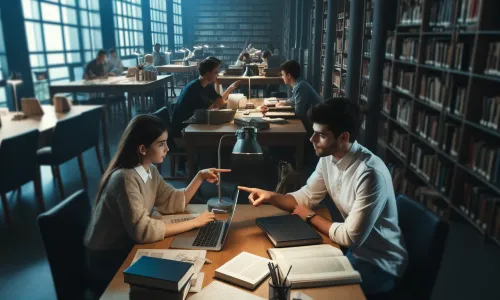Answers For Amina's project
Answers and detail explain for Amina's project
Explain
Amina's project

SECTION 3
BRYSON: Well, Amina, thanks for letting me have your draft in such good time.
AMINA: Oh, that’s alright. I was just very anxious to hear what you think of it. You can
see that I decided to change the topic - I had been interested in looking at Barings Factory.
BRVSON: 1Oh, I think the hospital was a much better choice. In fact... well... I have to say that I thought it was good.
AMINA: Oh?
BRYSON: There’s still lots of work to be done .. .
AMINA: Oh yes ... of course.
BRYSON: 2But there’s plenty of good ideas. It opens well and the first chapter is fine but the middle section really stood out for me ... most interesting.
AMINA: 3That’s amazing because I really didn’t find it a bit easy to write .. .
BRYSON: How long did you work on the whole thing?
AMINA: Well, I spent about two or three weeks reading and doing general research and
then I dashed the writing off very quickly ... so about four weeks in all.
BRYSON: Well, that’s about par for the course. You’ve got a while yet to make the changes.
AMINA: Oh right... no problem ...
BRYSON: Right. Let’s have a look at my notes here. OK. Starting with section headings ... the broad divisions are good but you’ll have to re-do the actual headings.
I’ve made some suggestions in the margins ...
AMINA: OK. Thanks.
BRYSON: 4Now, this information on local housing ... I can see why you put it there but it really isn’t relevant to the approach you’ve taken.
AMINA: I think I see what you mean.
BRYSON: 5Now . . . what did I say about the interviews?
AMINA: I worked very hard on those. I really thought they were valuable.
BRYSON: 5They are, Amina, but they’re very complex and rather unclear at the moment. You’re going to have to spend a bit of time making the data a lot clearer.
AMINA: OK ... as long as you don't have to remove them altogether . . .
BRYSON: No, don’t worry.
AMINA: 6What about the chronology ... the list of dates? I wasn’t sure whether I should rewrite those.
BRYSON:6 My advice on that is to take them out. I feel it makes the whole piece appear too simplistic.
AMINA: OK, if it’ll help.
BRYSON: Now, there are a couple of other books I’d like you to look at. Have you got a
pen? Right. . . Approaches to Local History by John Mervis . . .
AMINA: Right.. .
BRYSON: 7And then I think you need to think about ways of representing interview data. Have a look at Sight and Sound by Kate Oakwell.
AMINA: Sight and Sound.
BRYSON: Then you know I’m going away on holiday next week . . .
AMINA: Yes.
BRYSON: 8So when you’ve made the changes I suggest you show the work to your Support Tutor.
AMINA: Support Tutor . . . right. . .
BRYSON: 9Then you do the proofreading . . .
AMINA: Proofreading . . . uh-huh. When by, do you think?
BRYSON: 10I’d aim for 29 June and after that you should get it laser printed . . . but be careful because the computer center closes on 10 July.
AMINA: And then I hand it in to ... ?
BRYSON: Oh, the Faculty Office as usual.
AMINA: OK, that’s fine. I think I’m all set now! Thanks very much for all your help.
BRYSON: A pleasure. See you when I get back.
AMINA: Yep. Thanks, Dr Bryson. Bye.
BRYSON: Bye.
Question 1-3: Choose the correct letters A—C.
1Amina’s project is about a local
A.
B.
C.
2Dr Bryson particularly liked
A.
B.
C.
3Amina was surprised because she
A.
B.
C.
Questions 4 - 6:
What suggestions does Dr Bryson make? Complete the table as follows.
|
Write A if he says KEEP UNCHANGED Write B if he says REWRITE Write C if he says REMOVE COMPLETELY |
What suggestions does Dr Bryson make? Complete the table as follows.
Correct answer: C
Correct answer: B
Correct answer: C
Complete the notes below. Write NO MORE THAN THREE WORDS AND/OR A NUMBER for each answer.
Schedule of action:
Read “Approaches to Local History” by John Merivs
Read 7 (Sight and sound) By Kate Oakwell
Make changes and show to 8 (support tutor)
Do 9 (proofreading | proofread) By 29 June
Laser print before 10 (10 July | July 10th)
Hand to Faculty office
![[Forecast Q2-2025] - Biology lecture](https://static.helik.app/reading/8fd3d7d2-ccf9-47a3-8920-2e7a3b0d6607)
![[Forecast Q2-2025] - Living in the City](https://static.helik.app/reading/1a60bcf3-f3a7-4e9b-97a2-94d156a0de3b)
![[Forecast Q2-2025] - Student Union](https://static.helik.app/reading/fb443123-8c1d-447e-8c79-5a01650f4754)
![[Forecast Q2-2025] - Fruit-picking Job in an Orchard](https://static.helik.app/reading/e1968346-6c55-44ae-b8d3-f6a4fb7207b9)
![[Forecast Q2-2025] - University Crime Prevention](https://static.helik.app/reading/bdda593e-16d6-4c72-8a12-b116e917b27c)
![[Forecast Q2-2025] - Business Course](https://static.helik.app/reading/3308e282-99a6-4bcb-9d22-0b488701d968)
![[C20T1] - Choosing a restaurant](https://static.helik.app/reading/e9b21123-c43c-42fb-88b7-5d0be3a37e03)
